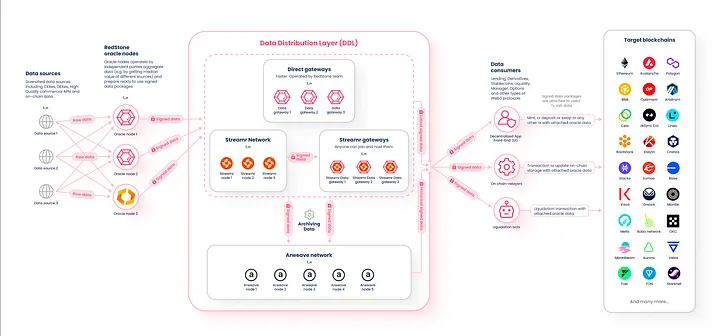RedStone has emerged as a trailblazer in the decentralized finance (DeFi) space, distinguished by its efficient and reliable Oracle system. However, what truly sets RedStone apart is its cutting-edge modular design. This innovative approach enhances the flexibility, scalability, and overall effectiveness of RedStone’s data delivery, marking a significant shift in the Oracle landscape.
Let’s take a closer look at the inner workings of RedStone’s modular architecture and how it is revolutionizing data delivery in DeFi.
The Concept of Modular Design
At its heart, modular design involves breaking a system down into smaller, self-contained components that work independently but integrate seamlessly. This contrasts sharply with traditional monolithic architectures, where all parts are tightly connected, making scalability and maintenance a complex challenge.
Key Benefits of RedStone’s Modular Architecture
1. Flexibility
One of the core strengths of RedStone’s modular approach is its incredible flexibility. By dividing the system into independent modules, each handling specific tasks, developers can easily customize or extend functionality without disrupting the entire system. This adaptability allows DeFi protocols to quickly meet evolving needs and seamlessly integrate new features.
2. Scalability
RedStone’s modular design promotes unparalleled scalability. Individual modules can be scaled horizontally or vertically to handle increasing demand for data feeds or the addition of new assets. This scalability ensures that RedStone can grow with its user base, maintaining top-tier performance even as data volume and traffic increase.
3. Fault Isolation
In a modular system, failures are contained within a specific module, minimizing the impact on the overall infrastructure. This fault isolation strengthens RedStone’s robustness, allowing the Oracle system to continue operating smoothly even when individual components encounter disruptions.
4. Ease of Maintenance
RedStone’s modular setup makes maintenance far simpler. Developers can update or debug individual components without affecting the entire platform. This reduces downtime and the risk of unintended side effects, streamlining the development process.
5. Interoperability
Modularity also enhances interoperability. Each of RedStone’s components exposes well-defined interfaces and protocols, making it easier to integrate with other DeFi protocols, blockchain networks, and data sources. This seamless communication across platforms expands the ecosystem and maximizes RedStone’s reach.
Core Components of RedStone’s Modular Architecture
-
Data Availability LayerThe foundation of RedStone’s system, this module acts as the entry point for incoming data feeds. By temporarily storing data in a decentralized cache, it reduces latency and ensures quick, reliable data access for DeFi applications.
-
Integration ModelsRedStone supports three distinct integration methods, each tailored for different use cases:
-
RedStone Core: Dynamically injects data into transactions for maximum gas efficiency and a streamlined user experience.
-
RedStone Classic: Pushes data on-chain through relayers, ideal for protocols using traditional Oracle systems.
-
RedStone X: Designed for advanced applications like perpetuals and derivatives, delivering ultra-low latency price feeds to counter front-running risks.
-

-
Data Aggregation MechanismsRedStone aggregates data from multiple sources using independent nodes managed by data providers. To ensure accuracy and integrity, it employs methods such as median pricing, Time-Weighted Average Price (TWAP), and Last-Weighted Average Price (LWAP). Additionally, safety features like outlier detection further safeguard the reliability of data.
-
On-Chain AggregationTo bolster security, RedStone requires multiple signatures from authorized data providers before returning aggregated values to consumer contracts. This multi-signature approach minimizes the risk of data manipulation, providing a high degree of trust in the information being delivered.
Conclusion
RedStone’s modular design redefines the capabilities of decentralized Oracles, bringing unmatched flexibility, scalability, and fault tolerance to the DeFi ecosystem. By embracing this forward-thinking architecture, RedStone empowers developers to confidently build cutting-edge applications, knowing that they have a robust and adaptable Oracle system at their disposal.
As the DeFi landscape continues to evolve, RedStone will remain at the forefront, driving innovation and democratizing access to reliable, decentralized data across blockchain networks.




评论 (0)